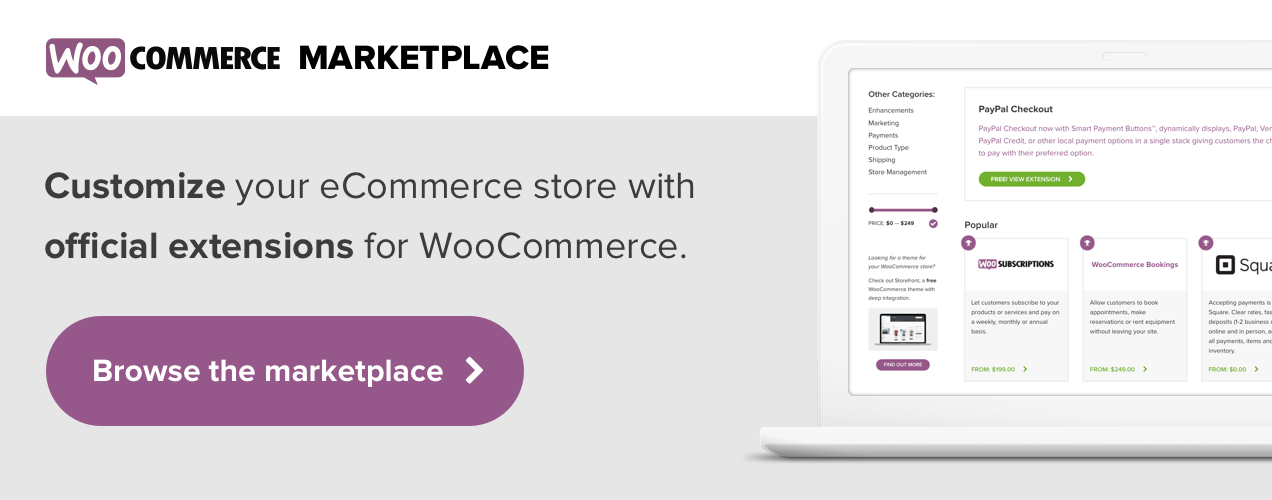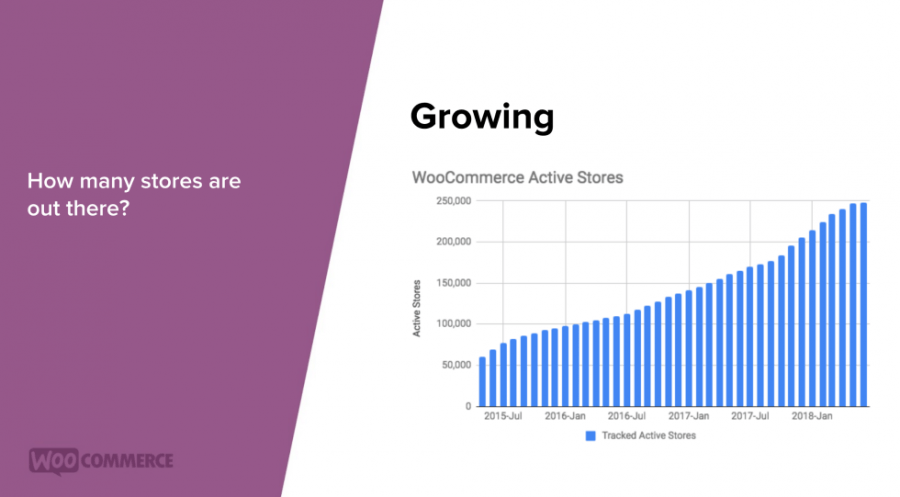Earlier this year, as we were planning for the year and beyond, one thing became clear: we could up our game when it came to understanding who we serve.
While we were already talking to customers, using our Ideas Board for feedback, and working with our customer service teams to hear what customers were saying to them, we wanted to add another dimension to be even more customer-centric: quantitative data.
To get there, we dug into the usage data that users share with us and then ran a comprehensive survey to layer in additional detail. In the process, we learned many surprising things that shape how we make products today – these are the top nine.
Finding The Data: Usage Tracking and Surveys
We started by looking at usage data from the WooCommerce Tracker, which includes information from 250,000 active stores that chose to send us data. Active Stores are sites that have made at least one sale, so we can assume they intend to have an online store.
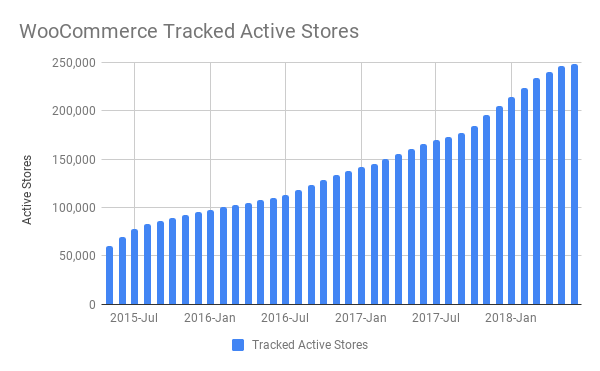
To get richer data about the people behind the stores, we also sent a survey to people who purchased something on WooCommerce.com — a theme, an extension, a bundle. We asked separate questions to people who manage stores (Business Owners) and people who build stores on behalf of others (Store Builders).
In general, the data was similar to previous research. WooCommerce stores typically offer complex products, including a variety of product types (memberships, appointments, etc.) and ways to pay (recurring, via invoice, etc.).
The surprises came when we ran a cluster analysis and identified four main types of customers:
- Established Business Owners: more traditional companies that have been in business for a while.
- eCommerce Newcomers: new folks stepping into the business world with their first online store.
- Agencies: teams of store builders that offer custom-coded solutions for clients.
- Assemblers: lone store builders that configure plugins and themes to deliver a complete solution to their clients.
Surprise #1: The largest percent of WooCommerce stores come from Europe
The first surprise came when we looked at where tracked active stores are based:
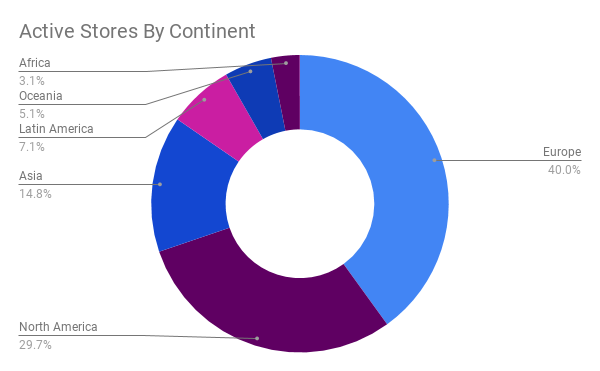
On the WooCommerce.com Marketplace, just over 50% of active subscribers come from North America — the United States is the second-largest eCommerce market in the world and nearly a third of WooCommerce tracked active stores are based in North America. But 40% of WooCommerce tracked active stores — the largest portion — are based in Europe.
To us, this suggested there was more we could be doing to better serve European stores. To that end, we’ve launched extensions for stores that have customers with different languages, want to accept multiple currencies, or want to offer special discounts to customers in different countries.
Surprise #2: Established Business Owners have a physical presence
While we may think of WooCommerce as a tool exclusively for online businesses, that wasn’t the case for a key group of our customers: Established Business Owners.
40% of Established Business Owners have a brick-and-mortar location, and 27% host events in physical locations.
These businesses often start with a physical presence — connecting with their audience through workshops or booths at a craft markets — and then go online to expand their reach, like Stems Brooklyn. This neighborhood flower shop started in 2013 by offering workshops and flower arrangements.
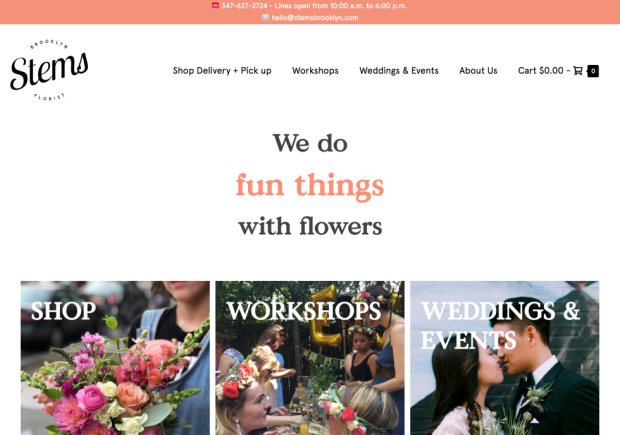
After a few years, Stems Brooklyn was ready to add a real-time online ordering to their business. The previous experience was manual, time-consuming, and frustrating — customers filled out a form and then sat waiting for a reply.
With WooCommerce, Stems Brooklyn now sells arrangements online. They also use the Square integration to connect their retail and online experiences.
For Established Business Owners like Stems Brooklyn, an online store is one piece of the business puzzle, alongside events and locations in the physical world. When all the pieces fit together, the business thrives.
Surprise #3: Established Business Owners are more likely to offer time-based products
Alongside a physical presence, Established Business Owners frequently offer time-based products, like:
- Appointments
- Reservations
- Classes
- Tickets to events
To compliment these offerings, these businesses are also more likely to take payment after purchase (such as via invoice) or offer a deposit or payment plan.
Phi Phi Pirate use WooCommerce Bookings to take online reservations for tours of Thailand’s Phi Phi Leh island on their custom-built pirate ship. Customers can check availability and instantly book tickets from the site. At Car2Go Biludlejning, the car rental arm of Denmark’s largest and oldest Nissan retailer, WooCommerce Bookings lets people reserve short- or long-term rental cars.
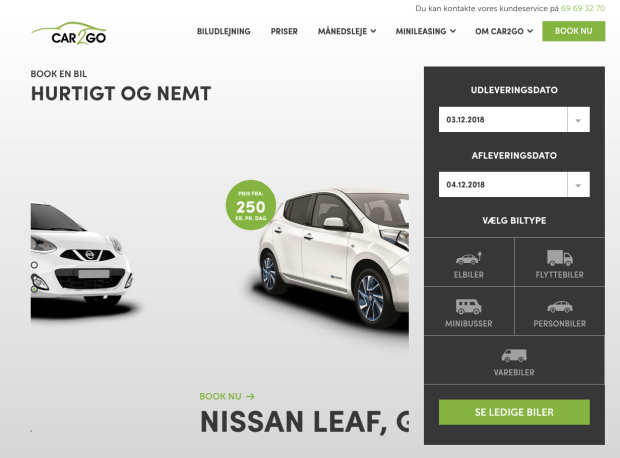
Whether it’s tours in Thailand or driving in Denmark, Established Business Owners offer bookings for physical services through their online stores, helping bring the puzzle pieces of their business together.
Surprise #4: Some WooCommerce businesses pre-date WooCommerce!
WooCommerce launched seven years ago, in 2011, but a third of Established Business Owners have been in business for more than ten years.
They typically hadn’t tried other eCommerce platforms, which suggests while their online store journey has been right alongside us, their business journey started before they found WooCommerce. That reinforces the idea that, for these business, their online store is just one element of a successful business plan.
The flip side was also true: eCommerce Newcomers (as the name suggests) are new to eCommerce, but are also new to their business. For Newcomers, their business is entirely online, and started with WooCommerce.
Surprise #5: eCommerce Newcomers start with physical products — and then move on
When I think of eCommerce, I think of a store selling physical goods that I buy with a credit card via a checkout process and that are then shipped to me. But in general, WooCommerce stores don’t fit this mold: they sell multiple types of product, and offer multiple ways to pay.
Some WooCommerce stores do start with traditional eCommerce, as 78% of eCommerce Newcomers offer physical goods and 86% ask customers to purchase via credit card at checkout.
But after starting with traditional online sales, eCommerce Newcomers often add the types of products and payments that are most accessible to them: digital products that don’t require additional infrastructure, or recurring subscriptions, which are an easy way to boost revenue. 29% of Newcomers offer digital products and 17% offer a subscription.
Scratch Pet Food sells grain-free pet food, with no artificial preservatives and completely recyclable packaging. To make sure your pet has what they need, when they needs it, Scratch also offers a pet food subscription service, on a schedule personalized for your pet’s needs.
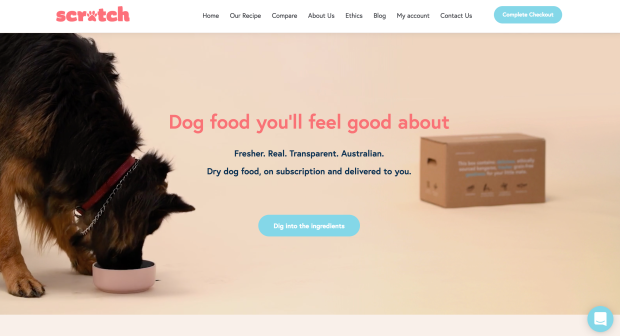
Surprise #6: Big stores don’t always turn to big companies for help
In some ways, Agencies — teams that offer custom-coded store solutions — work the way I assumed they would:
- They’ve been in business for a while, with 60% in business for more than five years.
- They work on lots of projects, typically more than 10 projects in a year.
- They’ve experimented with other eCommerce platforms besides WooCommerce.
Similarly, Assemblers, the one-person-bands who combine and configure themes and plugins to create a solution that feels custom, also worked as expected:
- They tend to spend more on themes than agencies, since that’s a core part of their offering
- They generally haven’t tried other platforms.
But there was one difference I expected to find that just wasn’t in the data:
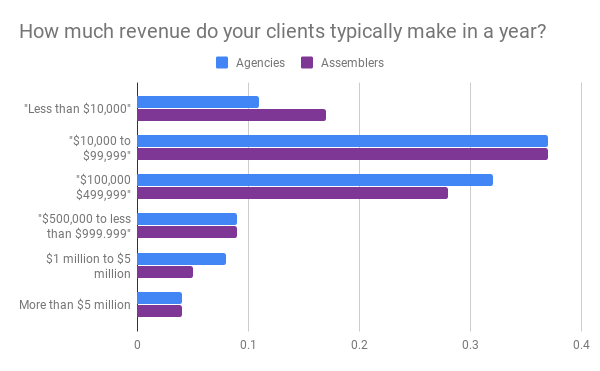
Both Agencies and Assemblers reported working with stores that made $500K or more last year, showing that larger businesses do not exclusively turn to agencies.
Surprise #7: Assemblers may get more control than Agencies
Along with the assumption that larger companies would tend to work with larger builders, I also assumed that Agencies had more say over their clients’ technology decisions. Actually, the opposite was true.
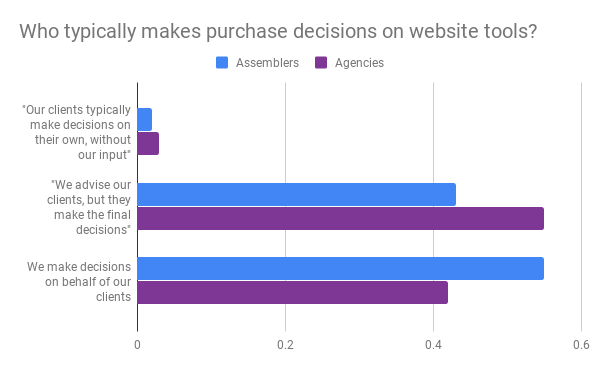
This changed how I imagined the relationship between Assemblers and their clients, and conversation with Assemblers reinforced this data. When a store owner turns to an Assembler, they want someone to take charge of the technology powering their online store, and they’ll put a lot of trust into an Assembler to make that happen.
Surprise #8: Agencies and Assemblers are both inexperienced with REST APIs
We asked Agencies and Assemblers to rate their experience with a range of technical issues that are important for building a WooCommerce store.
In general, both were very familiar with configuring plugins and themes and writing HTML and CSS, while Agencies were a bit more experienced than Assemblers with languages like PHP and JavaScript. That fit my mental model of Agencies as more “technical.”
But when it came to the REST APIs — a set of tools built into WordPress and WooCommerce that let developers build software applications that works with them — neither group has much experience.

More than 50% of agencies said they had little or no experience with either the WordPress or WooCommerce REST APIs, and more than half of assemblers said they had no experience with either.
Surprise #9: WooCommerce isn’t just for newbies, or just for Builders
Finally, the survey challenged two well-established, somewhat contradictory myths: that WooCommerce is for new businesses, not large successful stores, or that it’s only for Builders.
In our research, Established Business Owners were the most common customer type and Business Owners outnumbered Store Builders 2:1.
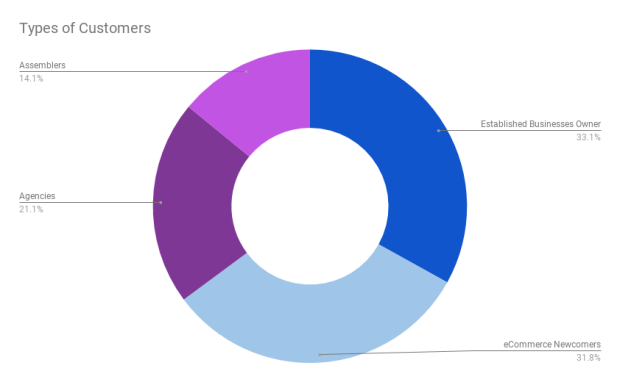
Join us on the exciting (and surprising) WooCommerce journey
If you’d like to to dig in deeper, I first shared these numbers earlier this year at WooSesh — you can watch the whole presentation here. Which of the surprises caught your attention? Has your own research differed? Whatever your WooCommerce experience, I’d love to hear from you in the comments.
We’re excited to be building products, services, and a platform that make eCommerce on the open web accessible to people all over the world – and look forward to more surprises in the months and years to come as we continue to dig into data and focus on customer insights.
